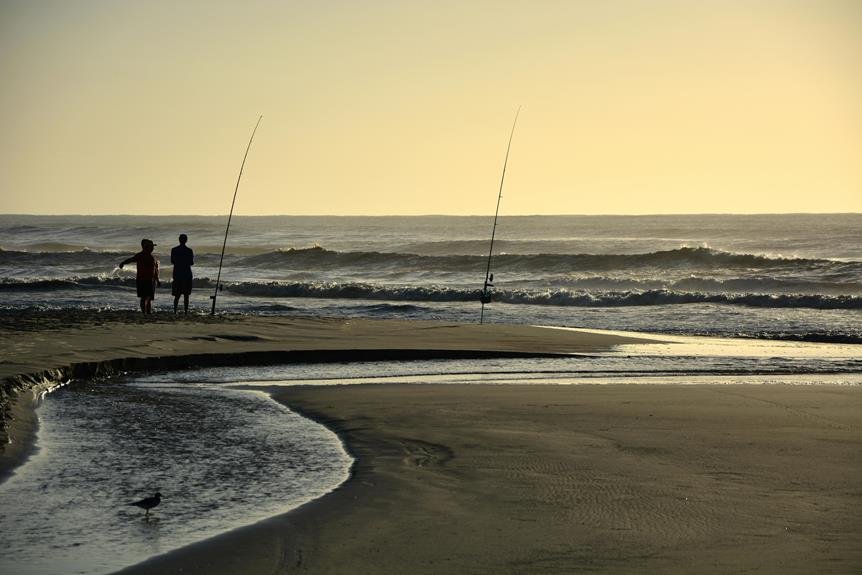The million-dollar duck band legend, a fascinating piece of hunting lore, has been debunked, tracing back to the 2003 National Waterfowlers Registry's $1 Million MegaDuck Challenge. This contest sparked widespread excitement among hunters, fueling the creation of duck folklore. However, concerns about the integrity of banding data led to the US Fish and Wildlife Service's opposition, resulting in the contest's abandonment. As the myth evolved, the importance of accurate data collection was overshadowed, threatening the accuracy of harvest rate calculations. Unravel the mystery behind this urban legend and discover the significance of accurate data in waterfowl management.
Key Takeaways
- The million-dollar duck band legend is an urban myth, debunked as a distorted version of a real, abandoned contest.
- The 2003 National Waterfowlers Registry's $1 Million MegaDuck Challenge sparked the myth, but was opposed by the USFWS and eventually abandoned.
- The contest aimed to motivate hunters to report banded ducks, crucial for understanding duck demographics and flyway dynamics.
- Accurate data from band reporting is essential for effective waterfowl management, informing harvest rate calculations, habitat conservation, and species conservation efforts.
- The myth's perpetuation highlights the importance of preserving data integrity and promoting accurate reporting in waterfowl management.
The Million-Dollar Myth Debunked
Despite its widespread circulation among hunters, the legend of a $1 million reward for a duck band has been debunked, with its origins tracing back to a real, albeit abandoned, contest. The myth has been perpetuated through 'bar room banter' among hunters, becoming an urban legend over time. In reality, the National Waterfowlers Registry announced a $1 Million MegaDuck Challenge in 2003, which was eventually abandoned due to opposition from the U.S. Fish and Wildlife Service. The goal of the contest was to motivate waterfowl hunters to report their bands, a vital aspect of waterfowl management. Accurate band reporting is essential for informing harvest rate calculations and effective duck hunting practices.
Origins of the Legend
The origins of the million-dollar duck band legend can be traced back to the 2003 National Waterfowlers Registry's $1 Million MegaDuck Challenge, which, although abandoned, left a lasting impact on the hunting community's collective imagination. This event sparked a firestorm of excitement among hunters, fueling the creation of duck folklore. The concept of a lucrative reward for a duck band captured the imagination of hunters, solidifying its place in hunting culture. Over time, the story morphed into an urban legend, with variations emerging, and details becoming distorted. Despite its abandonment, the MegaDuck Challenge's legacy lives on, perpetuating the myth of the million-dollar duck band. This phenomenon speaks to the power of storytelling in hunting culture, where tales of adventure and fortune can take on a life of their own.
The MegaDuck Challenge
In 2003, the National Waterfowlers Registry launched the $1 Million MegaDuck Challenge, a unique contest that sparked widespread excitement among waterfowl hunters. The contest aimed to motivate hunters to report banded ducks, vital for understanding duck demographics and flyway dynamics. The challenge involved randomly selecting 64 drake ducks, with one duck in each flyway worth $250,000 and 15 additional bands worth prizes. This innovative approach leveraged prize incentives to boost hunter engagement and band reporting rates. However, the contest was eventually abandoned due to opposition from the US Fish and Wildlife Service, which feared the contest could influence a publicly-funded and critically important primary data set. Despite its demise, the MegaDuck Challenge remains an intriguing example of creative banding methods and the complexities of hunter engagement.
USFWS Opposition Explained
Concerns about the integrity of banding data drove the US Fish and Wildlife Service's (USFWS) opposition to the MegaDuck Challenge. The agency's primary concern was the potential impact on the accuracy of harvest rate calculations, which are critical for informing waterfowl management decisions. The USFWS prioritizes the integrity of banding data to guarantee that conservation goals are met.
- Federal oversight: The USFWS is responsible for verifying that banding data is collected and reported accurately, and the MegaDuck Challenge could have compromised this process.
- Wildlife priorities: The agency's primary focus is on conservation and management of wildlife populations, and the contest could have detracted from these priorities.
- Regulatory hurdles: The USFWS has strict guidelines for banding and reporting, and the MegaDuck Challenge could have created regulatory hurdles that would have hindered the agency's ability to achieve its conservation goals.
The Importance of Accurate Data
Accurate data is the cornerstone of effective waterfowl management, as it enables conservationists to make informed decisions that impact the long-term sustainability of species populations. High-quality data is essential for understanding population dynamics, migration patterns, and habitat requirements. In the context of waterfowl management, accurate data informs harvest rate calculations, habitat conservation, and species conservation efforts. Research methods, such as banding and surveying, provide valuable insights into population trends and habitat use. Ensuring data quality is vital, as inaccuracies can lead to misguided management decisions. By prioritizing data quality and employing rigorous research methods, conservationists can make informed decisions that promote the long-term sustainability of waterfowl populations.
Morphing Into Urban Legend
As the MegaDuck Challenge was abandoned, the original story of the $1 million reward began to morph into an urban legend, fueled by the existence of real reward bands and distorted through incorrect recall and the conflation of similar stories.
The legend has spread through waterfowl hunters, with varying versions of the story emerging. Some claim it was a marketing ploy by Budweiser, while others believe it's a legitimate contest. The truth, however, remains elusive.
Here are three key aspects of this urban legend:
- Distortion through recall: The story has been altered over time, with details lost in translation.
- Conflation of similar stories: The $1 million reward has been linked to other tales, further muddying the waters.
- Fueling the myth: Real reward bands have contributed to the legend's persistence, leaving many to wonder if it's fact or fiction.
The result is a fascinating example of duck mythology, with waterfowl hunters continuing to speculate about the elusive million-dollar duck band.
Real Reward Bands Exist
Reward bands, a lesser-known aspect of waterfowl management, have been used to reevaluate changes in reporting rates and provide valuable insights into harvest rate calculations. These bands, used in duck tracking, have a rich banding history, dating back to the early 20th century. Initially, they were used to study bird migration patterns, but their purpose has since expanded to inform waterfowl management decisions. Real reward bands exist, offering incentives for hunters to report banded birds, which helps refine harvest rate calculations. By analyzing reporting rates, biologists can better understand duck behavior, migration patterns, and population dynamics. This valuable data informs conservation efforts, ensuring sustainable waterfowl populations for future generations.
The Consequences of Distortion
When the legend of the million-dollar duck band began to circulate, it sparked a chain reaction of misinformation that would eventually undermine the integrity of waterfowl management data. The distortion of facts led to Data Corruption, compromising the accuracy of harvest rate calculations. This, in turn, affected the reliability of management decisions, which are critical for the conservation of waterfowl populations.
The consequences of distortion can be summarized as follows:
- Data Corruption: Inaccurate information contaminates the data pool, leading to unreliable insights.
- Information Decay: The legend's perpetuation dilutes the significance of real reward bands, causing hunters to question the authenticity of the program.
- Compromised Decision-Making: Inaccurate data informs flawed management decisions, putting waterfowl conservation efforts at risk.
The legend's proliferation highlights the importance of verifying information to maintain the integrity of waterfowl management data.
Hunters' Role in Data Integrity
Accurate reporting of harvested waterfowl and recovered bands is the linchpin of reliable harvest rate calculations, placing hunters squarely at the forefront of maintaining data integrity. As the primary contributors to banding data, hunters bear significant responsibility in ensuring the accuracy and reliability of harvest rate calculations. Hunter accountability is vital, as incomplete or inaccurate reporting can skew data, ultimately affecting waterfowl management decisions. By embracing their role as data stewards, hunters can help maintain the integrity of the banding program, providing valuable insights for conservation efforts. By doing so, hunters not only contribute to the conservation of waterfowl populations but also to the advancement of scientific understanding.
The Value of Band Reporting
By reporting harvested waterfowl bands, hunters play a pivotal role in providing valuable insights into migration patterns, population dynamics, and habitat use, ultimately informing effective conservation strategies. This data is essential for wildlife management, as it helps inform policy and conservation efforts. Three key reasons why band reporting is essential are:
- Accurate population estimates: Band reporting helps scientists estimate waterfowl populations, which informs harvest regulations and conservation strategies.
- Habitat management: By understanding migration patterns and habitat use, conservationists can identify critical habitats that require protection and restoration.
- Hunter engagement: Band reporting fosters hunter engagement in conservation efforts, promoting a sense of ownership and responsibility among hunters.
Lessons Learned From Legend
As the legend of the million-dollar duck band continues to captivate hunters, it also serves as a poignant reminder of the importance of accurate data in informing waterfowl management decisions. The tale highlights the significance of reliable data quality in ensuring effective conservation efforts. Hunting ethics dictate that hunters report band data accurately, as it directly impacts harvest rate calculations and, subsequently, management decisions.
| Data Quality | Hunting Ethics |
|---|---|
| Accurate data informs waterfowl management | Hunters must report band data accurately |
| Inaccurate data compromises conservation efforts | Ethical hunters prioritize data quality |
| Reliable data ensures effective management | Hunting ethics hinge on accurate reporting |
| Data quality directly impacts conservation | Responsible hunting practices depend on data accuracy |
Preserving Data Integrity Matters
In the pursuit of effective waterfowl management, preserving data integrity matters greatly, as it forms the foundation upon which informed conservation decisions are made. Maintaining high-quality data is vital for accurate harvest rate calculations, habitat management, and population monitoring. To maintain data integrity, researchers and conservationists must adhere to strict research ethics, guaranteeing that data collection and analysis are conducted in a transparent, unbiased, and systematic manner.
To achieve this, the following measures are essential:
- Rigorous data validation: Verify data accuracy and completeness to prevent errors and inconsistencies.
- Standardized data collection protocols: Establish consistent methods for data collection to minimize variability and guarantee comparability.
- Transparent data reporting: Clearly document and report data collection methods, analysis, and results to facilitate transparency and accountability.
Frequently Asked Questions
What Happens to Unreported Duck Bands?
Unreported duck bands often remain lost treasures, relegated to a band graveyard, forgotten finds awaiting discovery. These metal mysteries hold wildlife secrets, their silence hindering harvest rate calculations and management decisions, emphasizing the importance of diligent band reporting.
Are Reward Bands Still Used in Waterfowl Hunting?
Reward bands remain an essential tool in waterfowl hunting, incentivizing hunters to report crucial data, informing wildlife studies and management decisions, while preserving cherished hunting traditions and promoting bird conservation.
Can Hunters Report Bands Online or by Mail?
Hunters can report bands through digital submissions, leveraging online platforms for convenient and efficient reporting, or opt for traditional mailing options, ensuring accurate data collection and contributing to informed waterfowl management decisions.
Do Hunters Need an Account to Report Duck Bands?
As the curtains of mystery lift, a beacon of clarity emerges: hunters can report duck bands online, sans the need for an account, upholding the pillars of hunting ethics while facilitating seamless duck tracking and data collection.
Are There Official Rules for Reporting Duck Bands?
When reporting duck bands, hunters must adhere to established banding protocols, ensuring data accuracy and compliance with regulations, while upholding reporting ethics, as accurate data informs waterfowl management decisions.
Conclusion
The duck band mystery, once shrouded in myth and misconception, has finally yielded to scrutiny. As the fog of legend lifts, the truth emerges, nuanced and multifaceted. Like an ornithological palimpsest, the story of the $1 million duck band reveals its complex layers, exposing the tangled threads of fact and fiction. In the end, it is not a tale of extravagance, but of the quiet diligence of data collection, a tribute to the power of accuracy and the importance of preserving the integrity of scientific inquiry.









